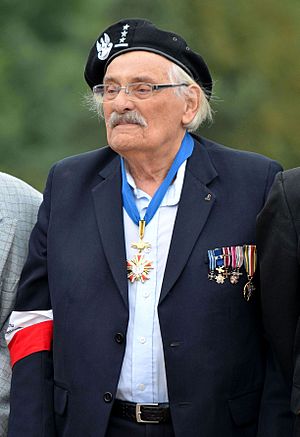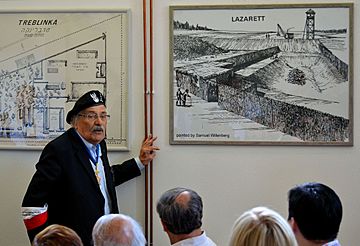Samuel Willenberg facts for kids
Quick facts for kids
Samuel Willenberg
|
|
|---|---|

Samuel Willenberg at Treblinka,
2 August 2013 |
|
| Born | 16 February 1923 Częstochowa, Kielce Voivodeship Poland
|
| Died | 19 February 2016 (aged 93) Udim, Israel
|
| Nationality | Polish, Israeli |
| Known for | Holocaust art |
| Movement | Realism, post-expressionism |
| Spouse(s) | Ada Willenberg (m. 1948) |
Samuel Willenberg (born February 16, 1923 – died February 19, 2016) was a brave Polish person who survived the Holocaust. He was also a talented artist and writer. During World War II, he was forced to work at the Treblinka extermination camp. He took part in a planned revolt by prisoners there in August 1943.
About 300 people escaped during the revolt, but only around 79 survived the war. Willenberg made it to Warsaw, where he joined the Warsaw Uprising before the war ended. When he passed away, Samuel Willenberg was the very last survivor of the Treblinka prisoner revolt from August 1943.
Like many other survivors, Willenberg later moved to Israel. He received some of Poland's highest awards. These included the Virtuti Militari and the Commander's Cross of the Order of Merit of the Republic of Poland. President Lech Kaczyński gave him this honor.
His book, Revolt in Treblinka, tells his amazing story. It was published in Hebrew, Polish, and English between 1986 and 1991. After the war, he also became a well-known sculptor and painter.
Contents
Life and His Experiences
Samuel Willenberg was born in Częstochowa, a city in Poland. His father, Perec Willenberg, was a teacher at a Jewish school before World War II. He was also a very good painter and artist. He earned money by decorating synagogues, which are Jewish places of worship.
Samuel's mother, Maniefa Popow, was a Polish-Orthodox Christian. She became Jewish after she married his father. The family lived in Częstochowa for a while before moving to Warsaw.
Germany Invades Poland
When Nazi Germany invaded Poland on September 6, 1939, Samuel was 16 years old. He decided to volunteer for the Polish Army and headed towards Lublin. Just a few days later, the Soviet army invaded Poland from the east.
On September 25, Samuel was badly hurt in a fight with the Red Army near Chełm. He was captured but managed to escape from the hospital three months later. He returned to central Poland to find his family in Radość, which is now part of Warsaw.
In early 1940, he, his mother, and two sisters went to Opatów. His father was working there, painting murals for the synagogue. Around this time, the Nazis started forcing Polish Jews into special neighborhoods called ghettos all over the country.
The Opatów Ghetto was created in the spring of 1941. It quickly became a very dangerous place. Many Jewish people from other areas were brought there. Because of the overcrowding and poor sanitation, a disease called typhus spread quickly.
Willenberg traded his father's paintings for food and other things they needed. He also worked for several months at a steel mill in Starachowice. Hundreds of other forced laborers, organized by the Judenrat (Jewish councils set up by the Nazis), worked there too.
In 1942, the Nazis began a terrible secret plan called Operation Reinhard. This plan was to kill Jewish people in the area they controlled, known as the General Government. This was the deadliest part of the Holocaust in Poland.
The Willenberg family managed to get fake "Aryan" papers, which made them seem non-Jewish. They escaped back to their hometown. The Ghetto in Częstochowa was set up on April 9, 1941. At its busiest, it held about 40,000 prisoners. Samuel's two sisters, Ita and Tamara, were taken there. His mother tried to save them and sent Samuel back to Opatów.
But on October 20, 1942, Samuel Willenberg was forced onto a Holocaust train. He was with 6,500 other prisoners from the Opatów ghetto, which was being emptied. They were all sent to the extermination camp at Treblinka.
Life in Treblinka Camp
The Treblinka camp was built as part of Operation Reinhard, the deadliest phase of the Final Solution. It operated from July 23, 1942, to October 19, 1943. During this time, more than 800,000 Jewish people—men, women, and children—were murdered there. Some estimates say over 1,000,000 people were killed.
When Samuel arrived at Treblinka, he received life-saving advice from another prisoner. He pretended to be a skilled bricklayer to show he could work. Luckily, he was wearing a paint-stained coat that belonged to his father. He had put it on in Opatów, preparing for forced labor. Samuel Willenberg was the only person from his transport of 6,000 people who survived the gas chambers that day.
At first, he was assigned to the camp's largest group, called Kommando Rot. Their job was to unpack and sort the belongings of victims who had already been killed. Later, he recognized the clothes of his own two sisters there, which confirmed they had been murdered.
Over time, he was assigned to other groups as number "937" in the Sonderkommando. One of their tasks was to weave tree branches into the barbed-wire fences. This was done to hide the camp grounds, buildings, and lines of prisoners.
On August 2, 1943, Willenberg took part in the revolt of the Sonderkommandos at Treblinka. About 200 to 300 prisoners joined the uprising. Unlike most of them, he managed to escape.
He was wounded in the leg but made his way back to Warsaw. There, he found his father, who was hiding in the "Aryan" part of the city. Samuel Willenberg then joined the underground resistance. He helped get weapons for the Polish People's Army PAL, a group of fighters. He used his mother's maiden name, Ignacy Popow, to stay hidden.
He was hiding in a safe house when the Warsaw Uprising began. In his book, Revolt in Treblinka, Willenberg wrote that he joined a fighting group called Batalion Ruczaj on the first day of the Uprising. He fought in the Śródmieście area of Warsaw. In early September 1944, he moved to the Polish People's Army as a young sergeant. After Warsaw surrendered, he left the city with other civilians. He escaped from a prisoner train and hid until the Soviet army arrived.
Life After the War
From 1945 to 1946, Willenberg served as a lieutenant in the Polish Army. In 1947, he helped Jewish organizations in Poland find Jewish children. These children had been saved from the Holocaust by Polish families who were not Jewish. He married Ada Willenberg, who had escaped from the Warsaw Ghetto by climbing over a wall.
In 1950, during a difficult time in Poland called Stalinism in Poland, Willenberg moved to Israel with his wife and mother. He trained to be an engineer surveyor. He got an important job as Chief Measurer at the Ministry of Reconstruction, helping to rebuild the country. He and Ada had a daughter named Orit.
After he retired, Willenberg studied fine arts. He graduated in sculpture from The Hebrew University of Jerusalem. He quickly became known for his art about the Holocaust. He mostly created sculptures of people and scenes using clay and bronze.
His series of fifteen bronze sculptures showed people and scenes from the Treblinka death camp. He also made several maps and drawings of the camp. These works were shown in art exhibitions around the world. Since 1983, he helped organize trips for Israeli youth to Poland, known as the March of the Living. These trips teach young people about the Holocaust.
In 2003, the Zachęta National Gallery of Art in Warsaw held an exhibition of his work. His sculptures were also shown at the Museum of Częstochowa in 2004. He created a monument to honor the 40,000 victims of the Częstochowa Ghetto. This monument was revealed in October 2009.
Willenberg first published his book Revolt in Treblinka in 1986. The English version was published in 1989. He later published it in Poland with a special introduction by Władysław Bartoszewski.
On February 19, 2016, Samuel Willenberg passed away in Israel. He was the last survivor of the Treblinka revolt. He was survived by his wife, Ada, their daughter Orit Willenberg-Giladi, and three grandchildren. Orit, who is an architect, designed the Israeli embassy in Berlin. It was finished in 2001. In 2013, she was chosen to design a Holocaust education center at the site of Treblinka.
Honors and Recognition
- After his death, Israeli President Reuven Rivlin spoke highly of Willenberg.
- Willenberg received Poland's highest national honors. These included the Virtuti Militari, the Cross of Merit with Swords, the Cross of Valor, the Warsaw Cross of the Uprising, and the Polish Army Medal. He also received the Order of Merit of the Republic of Poland from President Lech Kaczyński. Willenberg was the last survivor of the 1943 Treblinka prisoner uprising. His lifelong friend and fellow Treblinka survivor, Kalman Taigman, had passed away in August 2012.
Documentary Films
- Willenberg is the main person in the documentary film The Last Witness (Ostatni świadek, 2002). It was made by Michał Nekanda-Trepka with music by Zygmunt Konieczny. The film tells the story of the Treblinka extermination camp and the 1943 rebellion by prisoners, including his friend Kalman Taigman. This film won a silver medal at an international documentary film competition in Stockholm in 2002.
- Willenberg and Taigman also appeared in two other documentaries about Treblinka. One was a Uruguayan film called Despite Treblinka (2002). It also featured Chil Rajchman, another revolt survivor. Willenberg and Taigman were interviewed and filmed in Israel for this movie.
- BBC Four created Death Camp Treblinka: Survivor Stories (2012). It was written by Adam Kemp. This film showed Willenberg and Taigman as survivors of the revolt. It was also shown in the United States as Treblinka's Last Witness.
See also
- Jankiel Wiernik, a Treblinka survivor who wrote a book in 1944 called A Year in Treblinka.
- Chil Rajchman, a Treblinka revolt survivor who wrote a book in 1945 called The Last Jew of Treblinka.
- Kalman Taigman, a Treblinka revolt survivor and close friend of Samuel Willenberg.


